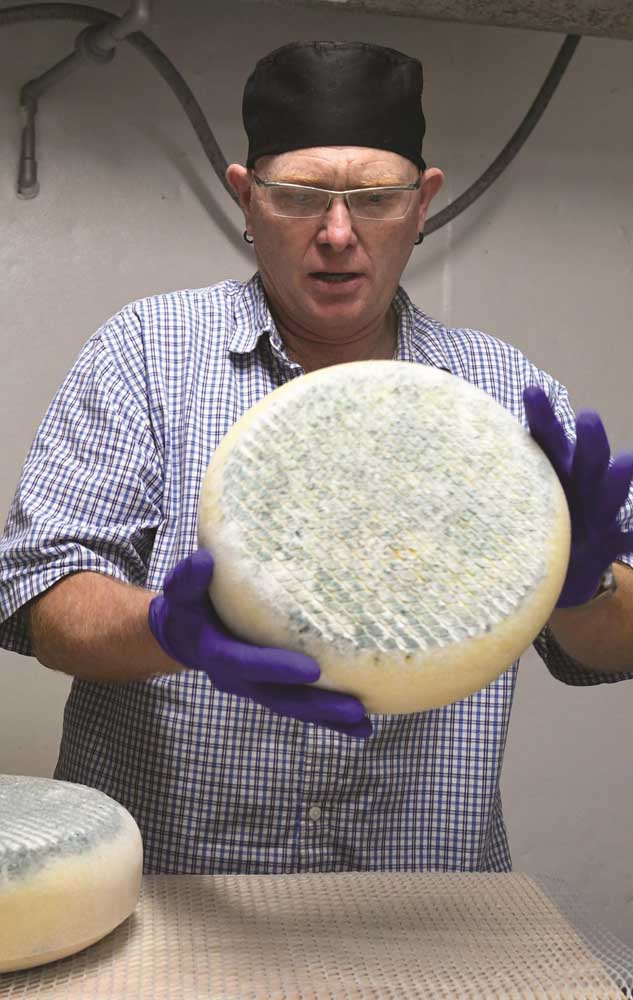GOATILICIOUS GOINGS-ON
Published 2:10 am Monday, May 6, 2019

- ROBERT RAGELS FLIPS a goat cheddar cheese wheel in New Braunfels, which is aging until about Thanksgiving. Ragels and his family do business as Ziegenhof and Goatilicious LLC. They harvest goat milk and create cheese.
NEW BRAUNFELS — There are about 70 goats in pens on a small New Braunfels ranch owned and operated by Robert Ragels.
The San Antonio Express-News reports each has its own personality, like Schnee, a charismatic Swiss breed that can recognize her name when Ragels calls it from more than 40 feet away. There’s also whimsically named Magnolia, Poppy, Ravenclaw and Snubie Q in the herd registered under the name Ragels Zigenhof.
They live a life under the careful watch of three guard dogs that monitor their safety with military precision and a rancher who cares for them like family. Each goat is milked twice and produces up to 2 gallons per day, and is housed in shaded comfort.
Ragels is in the process of turning his small Goatilicious operation into what he hopes will be region’s largest goat milk and cheesemaking facility.
“I don’t think it’s possible to make a fresher cheese than what we do here,” Ragels said. “From the milking process, it travels about 15 feet before we can start making cheese with it.”
Goatilicious cheeses, which range from feta, chevre, aged cheddar and Spanish varieties, are regularly sold at area farmers markets in New Braunfels and at the Pearl on weekends. The cheese also is starting to make its way onto area restaurant menus.
Muck & Fuss, a beer and burger restaurant in New Braunfels, features the chevre on its Scape Goat burger, and it’s in the process of developing a lamb burger that features the company’s feta.
Michael Bellamy, head chef at Muck & Fuss, said he wasn’t happy with the flavor of the goat cheese they had been using, so they switched. “I had known Robert for years from the markets, and we decided to use his cheese. It made everybody happy.”
According to the International Goat Association, goat milk is the most widely consumed milk in the world. It’s never been as popular in the U.S. as in Europe or Asia, but that’s changing.
“It’s definitely not something where there is an awareness issue anymore,” said Tony Hernandez, executive chef at Bliss in San Antonio. “The cheese has a great texture and the flavor has a nice tang to it. I love using it to fill pastas, stuffing meats and as a stand alone, it’s the perfect cheese for springtime and summer.”
Ragels, a military veteran, started a goat ranch in 1999 while living in Arizona as a way to provide healthier milk for his son Robin, who was overly sensitive to the traditional proteins in cow milk. The herd quickly multiplied from two starter goats to four, six, eight and more.
In 2005, the Ragels family and their goats moved from Arizona to New Braunfels after Robert was diagnosed with posttraumatic stress disorder. One of the prescribed treatments that was deemed effective was to work with animals.
“Not only did it help my son (with his milk issue), it helped me psychologically to get through the issues that I have to get through,” said Ragels, who operates the ranch with his wife Claudia, Robin and a small staff. “Being with the animals and catering to their needs … and have them depend on me, is a very peaceful experience.”
In addition to the milking goats, the ranch is surrounded with
pens holding free-range chickens, ducks, cows, an orchard of fruit trees and a pen of playful newborn goat kids. Everything is designed to work together.
“(Robert) has kind of a dream setup out there on the farm for people that want to be self-sufficient with their food,” said Stephen Paprocki, a San Antonio chef, business owner and president of the Chef Cooperatives group. “I would love to be in a setup like he has made for himself.”
Goatilicious is in the process of widespread expansion of his operations. Ragels, who started collecting goat milk with a hand-held extraction device and a bucket, is in the process of building out a full-blown dairy facility on his property that includes a 12-goat milking station, cheese-production space, a holding “cave” for aging cheese and a store for on-site sales of cheese and raw goat milk. Raw milk can only be sold at the production site.
The milking and cheese space is completed, but so far, Ragels said, the project has gone about $250,000 over budget. Chef Cooperatives will hold a food event featuring Goatalicious’ cheese to raise money for the ranch. The event will be held May 19 on the ranch, and tickets can be purchased at chefcooperatives.com/events.
Ragels said that he has a slight cheese shortage while he catches up after construction, but he should have triple his usual inventory by Thanksgiving. Depending on the variety, new cheeses need from three to eight months to fully develop in the climate-controlled cave.
“When we are up to full capacity, I should be able to produce 500 pounds of cheese per week, and we could have between $75,000 to $100,000 in our inventory,” Ragels said. “We want to be the primary source of goat cheese in San Antonio.”
And the faithful goats like Gold Dust and Kissy are more than happy to help, fighting one another for the next opportunity to give Ragels his daily supply of milk to work his magic.






